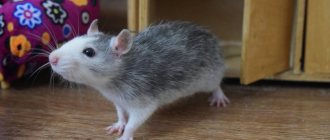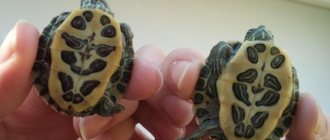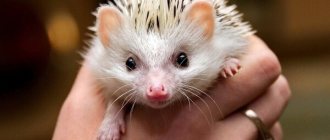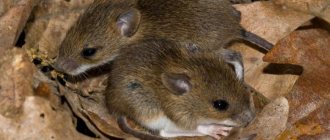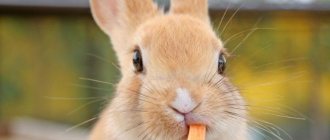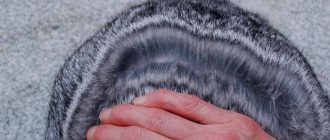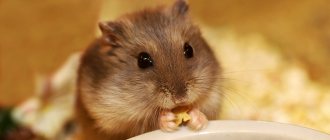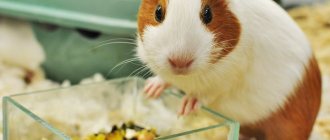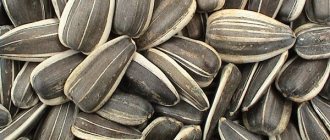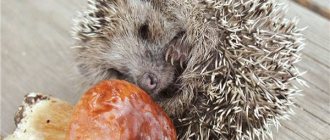All people have seen hedgehogs – some live, some in pictures. The animal is miniature in size and looks cute, but it is better not to pet it due to the large number of spines. In photographs you can often see a hedgehog carrying berries, fruits and mushrooms on its back. It becomes clear what he eats in the wild. If a person wants to have such a pet, then he should first find out what hedgehogs eat and how to properly care for them. If you create comfortable conditions, then you will be able to keep the animal and observe its behavior without any problems.
What does a hedgehog eat in nature?
The hedgehog is a small prickly predator. In nature, it feeds on insects, snails, worms, larvae, beetles, and frogs. Since it is a predatory animal, it often preys on small rodents.
Many gardeners even welcome it when a hedgehog comes to their site. He is a little house helper. With great pleasure, he eats pests on the site, thereby saving the harvest. Therefore, gardeners often feed wild hedgehogs in their summer cottages.
It also brings benefits by driving away all rodents and snakes from its territory. The hedgehog destroys the nests of mice, eating the offspring. And snakes are natural enemies of hedgehogs, like foxes, martens and owls. The hedgehog has an increased tolerance to snake venom, so bites are not scary for him, and he fights snakes without fear.
Where live
The habitat is wide, because hedgehogs are found in many European countries. They also live in Russia, and they can also be seen in hot Africa, New Zealand, the East and Asia.
Hedgehogs prefer to settle in steppes, deserts, cultivated landscapes, and forests. It is noteworthy that they can be found even in cities.
Hedgehogs have elongated middle fingers, which make it easy to clean their needles. The spines are hollow, and sparse hairs grow between them, which are almost invisible. The belly and head are covered with hair. On average, a hedgehog has approximately 10 thousand needles, which are updated regularly.
What to feed a hedgehog at home.
In its natural environment, a hedgehog independently determines its daily food intake. In the autumn, before hibernation, it deliberately eats up, gaining enough weight to survive the winter. At home, a hedgehog's nutrition depends entirely on the owner. Domestic hedgehogs are often fed prohibited foods, which leads to various diseases and reduced life expectancy.
A hedgehog's diet, both in nature and at home, mainly consists of food of animal origin. He needs to be fed meat and insects daily. You also need to include plant foods in your diet: vegetables, fruits, herbs.
Meat
To feed your hedgehog, you need to use lean meat. You can give beef, chicken, veal, turkey, duck, rabbit, horse meat. Hedgehog owners often wonder why they can’t feed their hedgehogs pork, even though they eat it with pleasure? Pork is very fatty, it will be difficult for a hedgehog to digest it, it disrupts the functioning of the digestive system.
The hedgehog should be fed meat daily, preferably raw. Raw meat is much healthier than boiled meat and contains a large amount of microelements. However, raw meat can contain parasites that cause illness. Therefore, periodically the hedgehog is given boiled meat. Both raw and cooked meat should be cut into pieces and placed in a bowl.
Many hedgehogs love minced meat rather than pieces of meat. It is very convenient to mix it with plant foods that the hedgehog refuses to eat.
It happens that owners find dead mice or birds and try to feed them to their pet hedgehog. Doing this is highly not recommended. The cause of death of rodents can be poison, and the cause of death of birds is various diseases.
Offal is also suitable as animal food. The liver, stomachs, tongue, and heart are often fed to the hedgehog, both raw and boiled. Preference is given to boiled offal, since heat treatment disinfects them.
In nature, hedgehogs destroy the nests of not only rodents, but also birds in order to feast on the eggs. At home, the hedgehog is fed chicken or quail eggs. You can give both raw and boiled eggs.
Fish
In its natural environment, a hedgehog does not eat fish because it does not have the opportunity to catch it. But fish can still be given to the hedgehog in small quantities. From fish, you can feed both low-fat sea fish and river fish. It is preferable to give mackerel; you can also feed pollock, mackerel, bream, perch, carp, crucian carp, haddock, hake, perch, whitefish, and pike. Before feeding the hedgehog, it must be boiled and the bones removed. You should not give salted or rotten fish, as this can lead to poisoning. Consumption in large quantities leads to vitamin deficiency and anemia.
Insects
Insects are the main type of food. which must be given daily. In the summer, you can collect insects in nature, preferably not in the yard, along the road, but in a clean place, preferably in fields or forests. Flies, beetles, snails, caterpillars, crickets, grasshoppers, locusts, larvae, and earthworms are suitable for feeding. Earthworms are very high in calories, so you can give 2-3 pieces at a time.
Insects can be purchased at a pet store. For hedgehogs they often buy:
- cockroaches (Turkmen or marble are suitable). Depending on the size, you can give 5-10 pieces at a time;
- domestic white crickets. Depending on the size, you can give 10-15 pieces at a time;
- mealworm. Considered a treat for hedgehogs;
- Zofobas. Feed once every 2 days, depending on the size, give 2-3 pieces.
Insects can be purchased both live and dried. Special mixtures of dried insects are sold. This mixture can be mixed with a boiled egg or minced meat. This makes a very nutritious food for your pet hedgehog.
Vegetables, fruits, berries
Vegetables and fruits must be given to the hedgehog daily. It is a source of vitamins and fiber. Fruits for hedgehogs include apples, pears, peaches, apricots, banana, watermelon, and melon. Vegetables include carrots, cucumbers, and zucchini. Potatoes contain a large amount of starch, so only give them a small amount when boiled. Vegetables are cut into pieces or can be grated. The fruits are cut into small pieces.
Berries include strawberries, wild strawberries, raspberries, cherries, blueberries, and cranberries. Before feeding cherries, be sure to remove the pit.
If your hedgehog refuses vegetables or fruits, you can try giving him pureed baby food. Or you can make your own puree from vegetables, fruits and berries.
Special food for hedgehogs
Buying special food for hedgehogs can be difficult because it is not the most common product. It is often replaced with cat food. Among cat food, only premium and super premium food can be used. Cheap food is not suitable.
It is not recommended to feed your hedgehog this food every day; it is only suitable as a temporary replacement or supplement. Because it is specially formulated for cats and does not contain essential nutrients for a hedgehog's body.
You can purchase special foods at the pet store: Dajana Country Mix Exclusive granulated food for hedgehogs, Vitakraft Menu canned food for hedgehogs, Vitakraft Premium Menu combined dry food for hedgehogs.
Water
Water should always be freely available. Only drinking or filtered water can be given. To prevent the hedgehog from knocking over the bowl of water, it should not be high and heavy, it is advisable to secure it.
Prohibited Products
Few people know that milk is contraindicated for hedgehogs. Its presence in the diet of animals can lead to serious health problems and significantly shorten the pet’s life. Goat milk contains a large amount of glucose, so it can be fed to a small hedgehog.
Also on the list of prohibited foods that should not be given to prickly pets, even in small doses, are:
- sweets;
- chocolate;
- grape;
- pineapples and avocados;
- dried fruits;
- vegetable oil;
- fast food;
- food for cats, dogs and other pets.
When and how much to feed your hedgehog
Hedgehogs are nocturnal. Towards evening they come out of hiding and go hunting at night. Therefore, the hedgehog needs to leave food in the evening. If you leave food for your hedgehog in the morning or afternoon, it can become airy and spoiled.
An adult hedgehog weighs on average 800 grams. The daily food intake for 1 individual is 100-120 grams, depending on the weight of the hedgehog. Pregnant hedgehogs require a little more food, 150-180 grams. Hedgehogs are omnivores and are very active at night. If the hedgehog is lethargic and sleepy, you need to contact a veterinarian; the animal may be sick.
Some species of domestic hedgehogs hibernate. During this period before hibernation, the hedgehog's lethargic state is quite normal.
Video on the topic. What to feed your pet hedgehog.
Brief description of the animal
A hedgehog is an animal that is classified as a hedgehog, a type of chordate. The length of its body may vary, as there are different species of this family. On average, the body size is from 10 to 44 cm. Weight ranges from 300 grams to 1.5 kg. Hedgehogs have a tail that grows up to 21 cm in length, but can be smaller.
The skull is wedge-shaped, while the muzzle is elongated and has a pointed nose. The teeth are sharp, although small in size. There are 20 of them on top, and 16 on the lower jaw. Moreover, some varieties have up to 44 teeth. The front incisors are large and resemble fangs; with their help, animals eat their prey.
Hedgehogs have elongated middle fingers, which make it easy to clean their needles. The spines are hollow, and sparse hairs grow between them, which are almost invisible. The belly and head are covered with hair. On average, a hedgehog has approximately 10 thousand needles, which are updated regularly.
The average lifespan of individuals is 3-5 years. In indoor conditions they can live up to 10 years, because they will not die from their natural enemies. In the natural environment, hedgehogs can be hunted by wolves, ferrets, badgers, hyenas and other forest or steppe predators.
How to breed insects
What to feed a small hedgehog at home? If you plan to leave the hedgehog for a long time, you can take care of the constant presence of insects. At home, you can breed large mealworm larvae.
To do this, take a small tightly knit wooden chest (it is better to cover the inside of a wooden box with foil) or a plastic container. A small hole is made in the upper part for air access, tightly covered with a fine mesh.
Bran is poured into the box in several layers, separated by natural fabric or gauze. Now the mealworm larvae are placed in the container. They can be purchased at a pet store or market. The box is placed in a warm place. Mealworms develop into pupae and later into beetles. The bugs again lay eggs, from which worms emerge. Some of the worms are left for further reproduction. Bran is periodically added. Other insects can be bred in a similar way.
Food from the table
There are people who believe that since a hedgehog is an omnivore, any food is suitable for it. And they don’t have the question “what to feed a hedgehog at home.” Indeed, a hedgehog can eat dairy products, salted meat with spices, various cereals, soups, bread, etc. But it's not right! Do not allow family members to feed the beast from the common table. Salty, spiced, fried and fatty foods are extremely dangerous for the body of a wild animal. Food for the hedgehog is given raw or prepared separately.
Breeding
Breeding African pygmy hedgehogs is a very important step. Initially, carefully weigh the pros and cons. You should have enough free time to care for your pregnant hedgehog and babies.
How to determine gender
To determine the sex, hold the hedgehog in your arms so that its belly is visible. In females, the genitals are located next to the anus. In males, they are located at a distance of approximately 1 cm from the anus in babies and 2–2.5 cm in adults.
Mating
For mating to be successful, the hedgehogs must be in the same age category
Hedgehogs become sexually mature at 5.5–6 weeks. Animals should not have inbreeding until at least the 3rd generation, so babies must be separated by gender in advance. Weak and sick hedgehogs cannot be bred.
A young male cannot be mated with an adult female. Due to inexperience, he can cause aggression and be bitten as a result. Mating can be done at 5.5–6 weeks, not earlier.
A female can become pregnant before 5.5 weeks. This cannot be allowed. She may not bear offspring or refuse to feed the cubs. A female should not be allowed to mate for more than 11 weeks if she has never given birth. Fused pelvic bones can complicate childbirth and lead to the death of a hedgehog.
Mating takes 6–7 days. There is no point in keeping animals together any longer. If mating does not occur, place the hedgehogs for a week, and then connect them again.
Males can be bred every 2 weeks. Female - no more than 2 times a year. Otherwise, she will kill her hedgehogs.
Pregnancy
Pregnancy in hedgehogs lasts 34–36 days. In a couple of weeks, the female gains 10–50 g in weight. On the 25th day, it is already clear that the hedgehog is pregnant: she becomes rounder, and her behavior also changes. She begins to take care of herself, her gait slows down.
How to care for newborn hedgehogs
It is better to touch newborn hedgehogs only with a cloth.
In the first days of the babies' lives, the female behaves very nervously. She needs to be placed in a separate cage and ensure complete rest. Otherwise, she may refuse to feed the offspring or even kill them.
It is better not to touch small hedgehogs - the female may refuse them if she smells a person. But sometimes situations arise when holding a baby is simply necessary. In this case, wash your hands thoroughly with plain water, put on clean clothes and try to avoid any odors. When you pick up the baby, distract the female. The same must be done when you put it back.
For the first 2 weeks, hedgehogs eat only mother's milk, then she begins to bring them other food. By 2 months, hedgehogs are no longer completely dependent on their mother.
Price
You can buy a prickly animal at a pet store or nursery. The price of a hedgehog depends on a number of factors, including the type of animal, age, and color. The most affordable common hedgehogs start from 3,000 rubles. Exotic African hedgehogs can cost 12-15 thousand rubles.
When purchasing, it is important to purchase a healthy pet with clear eyes, without sagging skin, spots, or bumps on the skin. The baby's nose should be dry, without crusts. A sign of a sick hedgehog is “staggering syndrome” when walking.
Individuals with a characteristic gait usually have several diseases. The tummy of a healthy pet is evenly covered with fur, without bald spots or tangles. The acquisition of a prickly friend will definitely bring bright colors to the usual home life of any person.
Basic colors
For home keeping, select healthy hedgehogs that have been examined by a veterinarian. The color of the shell matters. Breeders bred dwarf animals of colored color. It may differ from the shade of the needles of the individuals that are the progenitors:
- White-bellied - white fur. The color of the needles is gray with light rings. The ears are small;
- Algerian - cream and light beige needles. The auricle is large;
- Salt and pepper – black mask. The nose and eyes are dark. The fur on the forehead, over the eyes and on the belly is white. The carapace is black with white spots;
- Gray – the mask is light brown, covers the cheeks, but does not go into the eyes. The rest of the fur is white. The needles are dark gray with white ends;
- Chocolate – dark eyes and nose, light brown mask. The skin has a pinkish tint. Color dark brown with white;
- Brown is the color of oak bark. The ends of the needles are light. The fur is white, the mask is beige;
- Cinnamon - all needles are colored light brown. The skin is pink. The mask does not appear;
- Tsinakot - 50% of the shell is colored light brown and 50% white. Colored and light-colored needles are arranged randomly. The skin is beige, the eyes and nose are dark. There is no mask;
- Shampoo – light beige color, red eyes, dark nose;
- Pinto - the shell on the head and neck is light brown. The spines on the back and sides are white.
African hedgehogs kept at home can have a combination of colors. Pinto is combined with another color, tsinacott, chocolate. There are albino hedgehogs or white ones with a dark mask.
Of the light colors, the most popular are Snowflake and White. Breeders are experimenting with the shade of the shell. White animals with black yokes on the crown of the head or black animals with a white forelock appear.
What do hedgehogs eat in the wild?
Hedgehogs are omnivores. The main diet of hedgehogs includes smaller animals and birds - mice, snakes or fish. The body of hedgehogs is adapted even to poison, so they are able to eat even vipers. Also, these prickly animals can eat:
- insects (chafer beetles, larvae or butterflies);
- fruits and vegetables (apple or beetroot);
- eggs and small chicks;
- worms;
- frogs or lizards.
In the wild, hedgehogs never store food for the winter.
Interesting! A hedgehog can eat up to 80 cockchafers in a day. But even this is not enough for him to get enough.
“Give” the hedgehog something with your own scent
Hedgehogs rely on their sense of smell more than they do on sight and hearing, and therefore your scent, accompanying the hedgehog wherever he feels calm, will allow the pet to get used to you very quickly. Take one of your old clothes - a T-shirt, sweater or shirt, wear it for a while (at least a few days), and then put it in your hedgehog's cage or house. If his house is too small for this, choose an item that you were going to throw away, and after wearing it, cut a piece of a suitable size. The most important thing is that there are no threads sticking out of this thing, otherwise the hedgehog might eat them.
After a few days, the hedgehog will understand that you smell the same as his calm and safe sleep, and therefore will strive to be near you during the day.
If you don't have something suitable, just take a piece of fleece, wool or some old blanket or blanket and sleep with it for a few nights. The item will also become saturated with your scent.
Store-bought feed
Preparing live food and calculating the diet takes a lot of time and effort, which is why many hedgehog owners prefer store-bought formulations. They are sold in several varieties of composition and form:
- Spike's Dinner dry food. UK made range. The composition includes poultry meat, feed wheat, rice, brewer's yeast, whole corn, flax seeds, chicken fat. The food is available in packs of 650 grams, the recommended amount for wild hedgehogs is 20 grams per day;
- T-RexFood pate. Wet food suitable for pet hedgehogs. Consists of chicken necks, house crickets (30%), carrots, apples, pumpkin and seaweed extract;
- complete dry food Menu, made in Germany. Contains grains, meat and by-products, shellfish, crustaceans, nuts, fruits, mealworms and vegetables. Can be used as the basis of the diet of forest and pygmy hedgehogs.
To keep a hedgehog at home, some people use cat food, as it is easier to find in the store. This type of nutrition cannot be called optimal, but it is acceptable. The main thing is to purchase super-premium holistic food; it should not contain soy, wheat or other starch-replacing products, dyes, etc.
